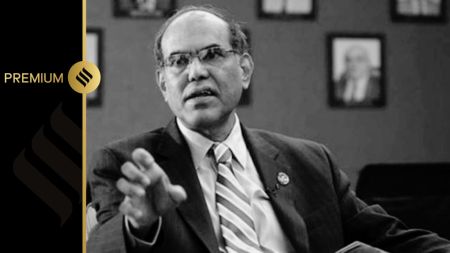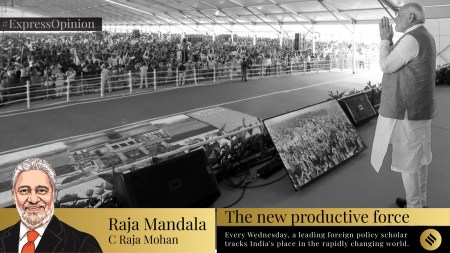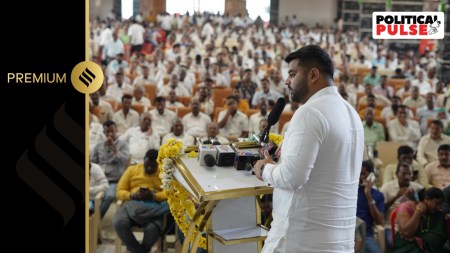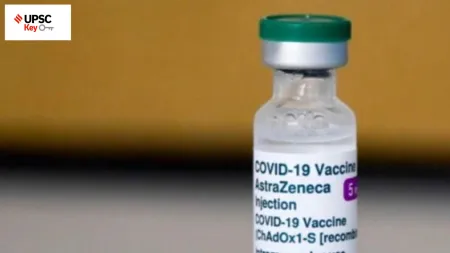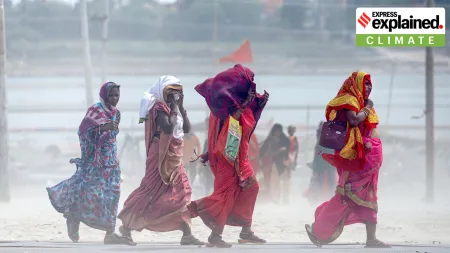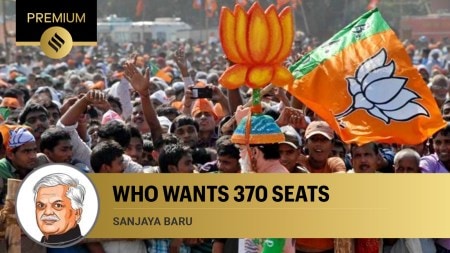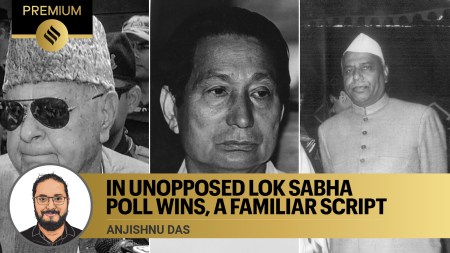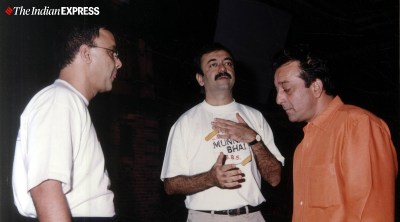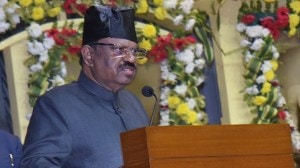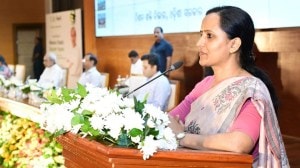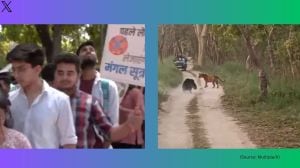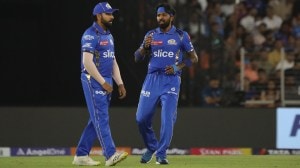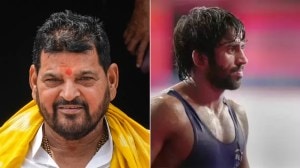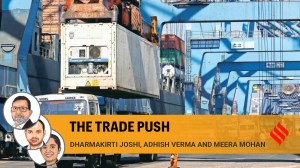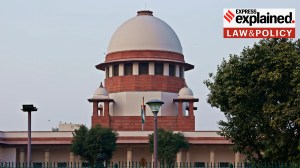- India
- International
UPSC Key— 15th April, 2024: Iran-Israel war, food security, allotment of symbols and more
Exclusive for Subscribers from Monday to Friday: How is India's stand on the Iran-Israel war and EV manufacturing in India are relevant to the UPSC Exam? What significance do topics like 'Dragon’s Egg' nebula and Food security have for both the preliminary and main exams? You can learn more by reading the Indian Express UPSC Key for April 15, 2024.
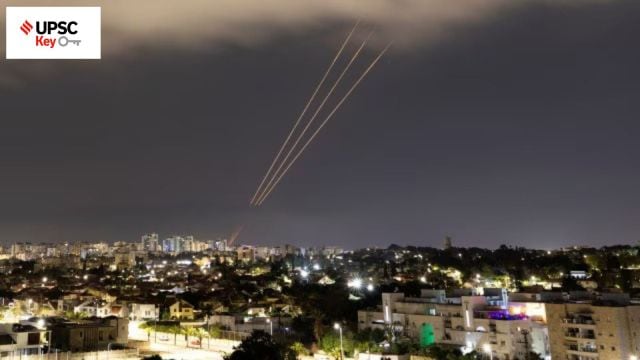 An anti-missile system operates after Iran launched drones and missiles towards Israel, as seen from Ashkelon, Israel April 14, 2024. Know more in our UPSC Key today. (Reuters)
An anti-missile system operates after Iran launched drones and missiles towards Israel, as seen from Ashkelon, Israel April 14, 2024. Know more in our UPSC Key today. (Reuters)Important topics and their relevance in UPSC CSE exam for April 15, 2024. If you missed the April 12, 2024 UPSC CSE exam key from the Indian Express, read it here.
FRONT PAGE
When Musk lands in India, the red carpet for Tesla — and a few red flags
Syllabus:
Preliminary Examination: Current events of national and international importance.
Mains Examination: Achievements of Indians in science & technology; indigenization of technology and developing new technology.
What’s the ongoing story- Elon Musk, the CEO of Tesla, is scheduled to arrive in India later this month to make an announcement regarding his plans to invest in electric vehicles (EVs). While he is sure to enjoy a warm welcome, there may be some cause for concern.
— Under pressure from local companies who have outwitted him in China, industry-wide digital disruptions, and a general slowdown in demand, Musk sees the India story as being just as vital as the EV story for India.
Prerequisites:
— Characteristics of electric vehicle
— EV policy in India
Key takeaways:

— The new EV policy lowered import duties to 15 per cent from 100 per cent on car models costing over $35,000 if its manufacturer promised to invest $500 million in setting up a local factory.
— Given that the duty cuts are intended to allow a carmaker to import fully built cars made in another nation, even though there is an implicit promise to build a factory at a later date backed by bank guarantees, and gradually increasing domestic manufacturing targets, this represents a partial reversal of the domestic manufacturing policy push.
— The waiver of duties is specifically for models of electric cars with a combined cost, insurance, freight prices of $35,000 or above, a user segment that does not qualify for a tax waiver.
— According to the Ministry of Commerce, the new policy “is designed to attract investments in the e-vehicle space by reputed global EV manufacturers” and seeks to “provide Indian consumers with access to latest technology, boosting the Make in India initiative, strengthening the EV ecosystem by promoting healthy competition among EV players, reducing imports of crude oil and reduce air pollution.”
— The steady slowdown in EV demand across key markets, including North America and Western Europe, has started to expose a major overcapacity problem at its factories such as Shanghai and Berlin.
Challenges
Lack of a mass-market entry-level
— The cheapest model of Tesla, the Model 3 sedan, sells for nearly $40,000 in the US and the planned low-cost Model 2 is a non-starter.
Less expensive Chinese vehicle
— Chinese EV manufacturers are catching up to Tesla quickly. The final three months of 2023 saw Shenzhen-based BYD overtake Tesla as the best-selling electric vehicle manufacturer, helped by a sharp increase in sales of the Chinese automaker’s more affordable, smaller EVs, such the Seagull and Dolphin models.
Charging network
— Tesla has been obliged to partially up its 45,000-charger network in the United States to all electric car models by the end of 2024 in exchange for access to $7.5 billion in subsidies. This completely eliminates Tesla’s advantage in constructing and maintaining a highly efficient fast charging network.
For Your Information:
— Electric models made up about 2% of total car sales in India in 2023 and the government wants to increase that to 30% by 2030.
— The objective of the new policy is to “strengthen the EV ecosystem by promoting healthy competition among EV players leading to high volume of production, economies of scale, lower cost of production.”
— Under the new policy, EV imports at a lower tax rate will be allowed for a maximum of five years and the total number will be capped at 8,000 a year.
— India’s charging infrastructure requires a major boost to alleviate range anxiety and drive widespread adoption. According to the Confederation of Indian Industry (CII) report estimates, to meet the projected demand, India needs to install over 13 lakh chargers by 2030.
Points to Ponder:
— Charging infrastructure
— Lithium-ion batteries
— Leading producer of EVs
— Import duty on imported cars
Post Read Question:
India’s EV market is small but growing. Discuss how importing electric vehicles and setting up a manufacturing unit will boost economy and employment.
Other Important Articles Covering the same topic:
In big win for Elon Musk’s Tesla, India to lower EV import tax if $500 million invested
With Tesla push, India mulls import tax cut if EV makers build locally
EV push: Automakers, energy majors join hands
FRONT PAGE
Iran attack: Israel debates response, US says won’t take part in retaliation
Contrast with October 7: Why Delhi’s shift mark key shifts in Mideast diplomacy
Syllabus:
Preliminary Examination: Current events of international importance
Mains Examination: GS II: Effect of policies and politics of developed and developing countries on India’s interests, Indian diaspora.
What’s the ongoing story- President Joe Biden warned Prime Minister Benjamin Netanyahu the US will not take part in a counter-offensive against Iran, an option Netanyahu’s war cabinet favors after a mass drone and missile attack on Israeli territory, according to officials. The threat of open warfare erupting between the arch Middle East foes and dragging in the United States put the region on edge, triggering calls for restraint from global powers and Arab nations.
Prerequisites:
— What is Hamas and the Israel Hamas War?
— What is the ‘Middle East’?
— Map work: Tel Aviv, Damascus, Tehran, key countries of the region: Egypt, Iran, Israel, Qatar, Turkey, Saudi Arabia, UAE, Red Sea, Strait of Hormuz, Persian Gulf, Gulf of Oman, Gulf of Aden, Bab-el-Mandeb.
— What happened on October 7?
— Why has Israel killed Iranian generals in Syria and who are the Quds Force?
Key takeaways:
C Raja Mohan writes- “India’s quick call for de-escalation today in the aftermath of Iran’s retaliatory strike against Israel stands in contrast to Delhi’s instant expression of solidarity with Tel Aviv at the highest political level immediately after the October 7 terror attack by Hamas. That contrast highlights four broad transitions in India’s engagement with the region.”
(1. If India was seen as taking “Israel’s side” on October 7, its position today urging restraint will be viewed as “balanced” and in favour of regional peace.2. Today, Delhi pays attention to the region’s internal contradictions. 3. India’s call for de-escalation also underlines that religion can’t be the dominant factor in dealing with the Middle East. 4. India’s interests in the region are no longer limited to oil imports and labour exports. Elaborate on these points from the article.)
For Your Information:
Why is Iran’s attack significant?
Although Iran and Israel have a long history of bitter conflict and covert military actions against each other, this is the first time Iran has launched a direct attack of this scale aimed at targets within Israel.
Points to Ponder:
— What is the history of Iran-Israel ties?
(Thought Process: The Iran-Israel relationship has not always been as fraught as it is today. Iran was one of the first countries in the region to recognise Israel after its formation in 1948. It was only after 1979 that their diplomatic ties ended. Three stages: Pre-1979 Iran-Israel ties, The 1979 revolution, A Shadow War after 1979)
— Who are the Iran-backed regional groups of concern and why?
1. Hamas and Palestinian Islamic Jihad,
2. Hezbollah
3. Houthis
Post Read Questions:
1. The Middle East is one of the most successful regions for Indian diplomacy over the last decade but it continues to test Delhi’s ability to navigate the region’s competing imperatives. Discuss.
2. What is India Middle East Europe Corridor (IMEC)?
3. Why does India not want Iran -Israel tensions to escalate?
(Thought process: Build on the following points – India has invested in a strategic relationship with major Arab countries, Iran, and Israel- India’s economic interests are tied to energy security, the West Asia region contributes to India’s 80 percent of oil supplies- Risk to the Indian community that is based in the region.)
Other Important Articles Covering the same topic:
India’s stakes in Iran-Israel conflict — and why it does not want tensions to escalate
Iran launches attacks on Israel: Who are the Iran-backed regional groups of concern?
A short history of Iran-Israel ties and why they soured after 1979
As Iran attacks Israel, four key questions on what is happening, why it matters
EXPLAINED PAGE
India’s hepatitis headache
Syllabus:
Preliminary Examination: General Science
Mains Examination: GS III: Science and Technology- developments and their applications and effects in everyday life.
What’s the ongoing story- According to the World Health Organisation’s (WHO’s) Global Hepatitis Report 2024, India has among the highest burdens of viral hepatitis.
— Hepatitis along with tuberculosis (TB) is the second largest infectious killer globally — in the world after Covid-19, according to the report.
— An estimated 1.3 million people died of viral hepatitis in 2022 (as compared to 1.1 million in 2019), even as its incidence — number of new cases in a year — went down to 2.2 million in 2022 (as compared to 2.5 million in 2019).
Prerequisites:
— What is hepatitis?
— Different types of hepatitis viruses
— World Health Organisation
— Universal immunisation programme
Key takeaways:
— There are five hepatitis viruses that cause liver disease in humans.
— Hepatitis A and E are transmitted through contaminated food and water, and result in weeks-long symptoms such as fever, abdominal pain, jaundice (yellowing of skin), dark urine, and pale stools.
— The WHO report, however, focuses on the blood-borne hepatitis B (hep B) and hepatitis C (hep C) viruses.
— Some of these viruses produce short-term infections that go away on their own, but others cause chronic life-long disease, cirrhosis (permanent scarring of the liver that reduces its efficiency), and an increased risk of liver cancer.
— Hepatitis B can be prevented with vaccination, whereas Hepatitis C can be treated with medication.
— The report does not consider hepatitis D that can only infect those who are already infected with hep B. It can thus be avoided by becoming vaccinated against Hep B.
What does the report say about India?
— The report found that India has the world’s second highest prevalence of viral hepatitis cases, accounting for over 11% of the global burden.
— According to the report, there were 254 million people living with hep B in 2022. India accounted for 29 million cases, second only to China (79 million cases). Of the 50 million people living with hep C in the world, India accounted for 5.5 million cases, just behind Pakistan’s 8.8 million cases.
— According to the report, only 2.4% hep B cases and about 28% hep C cases were diagnosed.
What is causing the rise in cases of viral hepatitis in India?
— Viral hepatitis can be transmitted through contaminated blood transfusions, or through contaminated needles.
— According to the Dr S K Sarin, vice chancellor of the Institute of Liver and Biliary Disease (ILBS), “Almost 90% of hep B cases in India are transmitted from mother to child, because most blood banks now provide safe blood, and needle-stick transmission in healthcare workers is limited because almost everyone is vaccinated.”
— As per the WHO report, India is one of 10 countries where 80% of infections of hep C are among injection drug users.
For Your Information:
Challenges in dealing with viral hepatitis
— According to Dr Sarin, there are more challenges to controlling hep B than hep C. Three things need to be ensured:
(i) Vaccination of all newborns against hep B.
(ii) Adults who have not been immunised should also be given the shot.
(iii) Those who are diagnosed with the infection should be put on treatment.
— Under the government’s universal immunisation programme, the hep B vaccine was rolled out for children in 2007-08.
— The 2018 National Viral Hepatitis Control Programme also makes provisions for vaccination of people at high risk of contracting hep B, such as healthcare workers.
Treatment
— The treatment for hep B is done by specialists according to an international guideline.
— The antiviral treatment for hep B slows the ability of the virus to damage the liver.
— Hep C can be treated by medication and it has good efficacy of 80 to 90 per cent. The treatment for hep C goes on for a shorter duration [12 to 24 weeks].
Points to Ponder:
— India’s response to viral hepatitis compared with TB
— Symptoms and treatment of TB
— Which vaccine is given to hepatitis B patients?
— Which country leads in hepatitis cases?
Post Read Question:
Consider the following statements about hepatitis:
1. India has the highest prevalence of viral hepatitis cases.
2. Hepatitis B can be prevented with vaccination, whereas Hepatitis C can be treated with medication.
3. Hepatitis A and E are not transmitted through contaminated food and water.
4. Most of the hep B cases in India are transmitted from mother to child.
How many of the statements given above are correct?
(a) Only one
(b) Only two
(c) Only three
(d) All four
Other Important Articles Covering the same topic:
Why surveillance of HIV drug resistance is essential
Allotment of Symbols to Political parties
Syllabus:
Preliminary Examination: Indian polity and Governance – Constitution, Political system, Panchayati Raj, Public policy, Rights issues, etc
Mains Examination: GS-II, Appointment to various constitutional posts, powers, functions, and responsibilities of various constitutional bodies.
What’s the ongoing story- Election symbols are a critical component of elections. They are a party’s identity, and help voters recognise candidates. When parties split, a battle is fought for its election symbol. Recently, the fight for the symbol was witnessed with the split of Shiv Sena party in Maharashtra.
Prerequisites:
— What are the constitutional articles related to the Election Commission?
— What is the role and function of the election commission?
— How Election Commission ensures free and fair elections?
Key takeaways:
— The need for election symbols was released by the Election Commission before the first Lok Sabha election of 1951 to fulfill the democratic process for the majority of the illiterate population.
— The main idea regarding party symbols was to select those symbols which are familiar and easily recognizable and should not hurt religious or sentimental associations.
— The Election commission of India (ECI), under the Election Symbols (Reservation and Allotment) Order, 1968, is responsible for the allotment of symbols.
— There are two types of election symbols- “reserved symbol” and “free symbol”.
— The reserved symbols are reserved for recognised political parties for exclusive allotment to its contesting candidates. A recognized political party shall either be a National party or a state party.
— Free symbols are allotted to independent and unrecognized registered parties.
For Your Information:
— The Party symbol ‘Hand’ was not the symbol of Congress during independence. The Election Commission allotted this symbol to Indian National Congress (I) on February 2, 1978.
— The symbol of lotus was allotted to the Bharatiya Janata Party on April 24, 1980 after it split from the Janata Party.
Points to Ponder:
— What are National parties and state parties?
— How regional parties become state parties or National parties?
— What is the Election Commission’s test of majority?
— If a free symbol has been chosen by several candidates in an election then how is it sorted out by the returning officer?
— What is the role of the returning officer?
Post Read Question:
Consider the following statements:
Statement I: The allotment of the party symbols are done by the Election Commission with the support of the Supreme Court.
Statement II: The Chief Election Commissioner is appointed by the Executive and the role of the judiciary increases to ensure transparency.
Which one of the following is correct in respect of the above statements?
(a) Both Statement-I and Statement-II are correct and Statement-II is the correct explanation for Statement-I
(b) Both Statement-I and Statement-II are correct and Statement-II is not the correct explanation for Statement-I
(c) Statement-I is correct but Statement-II is incorrect
(d) Statement-I is incorrect but Statement-II is correct
Other Important Articles Covering the same topic:
Hand, Lotus, noodle bowl, charger and more: How are symbols allotted to political parties in India?
Magnetic field of the dragon’s egg nebula
Syllabus:
Preliminary Examination: General Science
Mains Examination: Awareness in the fields of IT, space, computers, robotics, nano-technology, bio-technology and issues related to intellectual property rights.
What’s the ongoing story- Two large stars, residing inside a spectacular cloud of gas and dust nicknamed the ‘Dragon’s Egg’ nebula, have long presented a puzzle to astronomers. One of them has a magnetic field, like our Sun. But its companion does not. Moreover, such massive stars are not usually associated with nebulae.
Prerequisites:
— What is the binary system of planets?
— What is a nebula?
— What is magnetic field?
Key takeaways:
— According to the journal Science, the bigger star apparently gobbled up a third smaller sibling star and the mixing of their stellar material created a magnetic field.
— The ‘dragon egg nebula’ is so named because it is located near a larger nebula complex called the ‘Fighting dragons of Ara.’
— There is a triple system that started out 4-6 million years ago in the Dragon egg nebula.
— In the triple system’s the two innermost members included: a larger star (25-30 times the mass of the Sun) and a smaller star (5-10 times the mass of the Sun).
— The massive star evolved more quickly as the outermost layer engulfed the smaller stars, triggering a merger that ejected into the space gas and dust that make up the nebula.
For Your Information:
— The explosion of a star, a supernova recorded in the year 1,054 AD by 11th-century astronauts, led to the creation of the Crab Nebula, a supernova remnant.
— Light year is used to measure the distance between celestial objects.
Points to Ponder:
— How stars are formed?
— What is the process of dying of a star?
— What is the significance of the James Webb telescope?
Post Read Question:
Recently Dragon’s egg and Fighting dragons of Ara were in news, it is associated with
(a) Newly discovered species of scorpio
(b) Nebulas
(c) Constellation
(d) Newly discovered species of dragon
Other Important Articles Covering the same topic:
Details of crab nebula captured by Webb telescope
Webb telescope took image of Ring nebula
EDITORIAL PAGE
Food for reform
Syllabus:
Preliminary Examination: Economic and Social Development – Sustainable Development, Poverty, Inclusion, Social Sector Initiatives, etc.
Mains Examination: General Studies III: Issues related to direct and indirect farm subsidies and minimum support prices; Public Distribution System, Food processing and related industries in India- scope and significance, location, upstream and downstream requirements, supply chain management.
What’s the ongoing story- Ashok Gulati, Ritika Juneja and Purvi Thangraj writes:
“As the election campaign in India hits fever pitch despite rising temperatures, most pollsters are predicting a continuation of the incumbent government. Interestingly, the Narendra Modi government has already asked various ministries to prepare plans that they would like to announce in the first 100 days of their third term. The ministries are contacting various experts to help them frame the right policy framework that is in sync with the vision of Viksit Bharat@2047. Here are some of our suggestions for the agri-food space. They are based on our interactions with experts during the four-day forum organised by the Asian Development Bank on food security in the wake of climate change.”
The Central Question: India should consider a strategic initiative aimed at eliminating food insecurity in India and ensuring affordable access to achieve the goal of zero hunger.
Prerequisites:
— What is Food Security?
— Know about the Public Distribution System and National Food Security Act, 2013.
— What is agri-GDP growth?
— What is food inflation or consumer food price inflation?
— How extreme weather events triggered by global warming are affecting agricultural production?
— What is El Nino? How does it affect Indian agriculture?
— Know about climate-smart agriculture (CSA).
— What is the vision of Viksit Bharat@2047?
— What is DRR Dhan 45?
— What is Asian Development Bank?
— What are farmer-producer organizations?
Key takeaways:
— Food systems transformation is required- Ashok Gulati, Ritika Juneja and Purvi Thangraj writes: “With gradually rising incomes, people will demand more and better food. Efficiency in the use of land, water, labour, and inputs like fertilisers and farm machinery is going to be critical. In other words, we must aim to raise our total factor productivity. This can be done only by putting in more resources in agri-R&D, innovations and extension.”
— In the context of extreme weather conditions affecting the production system it is important to invest in climate resilient agriculture.– “The real solution lies in investing resources to create climate-resilient (smart) agriculture. This would mean more investments in seeds that are heat and flood-resistant, and more investment in water resources not just in augmenting their supplies but also ensuring water is being used more wisely. “More crop per drop” should not be just a slogan but a reality. Drips, sprinklers, and protected cultivation as part of precision agriculture will have to be adopted at a much larger scale than today.”
— Logistic advancement and a new set of rules is the need of the hour for not only transporting agricultural produce but also for its storage and processing. “By 2047, more than two-thirds of India will be living in urban areas — up from about 36 per cent today. Migration from rural to urban areas in search of higher productivity jobs is a natural process that cannot, and should not, be wished away. The implication of this is that much of the food will have to be moved from the hinterlands to urban areas. This would require a massive logistics revolution, from transporting to stocking to processing and organised retailing. This would open doors for large-scale investments, primarily by the private sector. The new government will have to facilitate this transformation by changing laws that are suitable for Bharat@2047.Many of our laws are those we inherited from the British in 1947. A fresh set of rules that are more market-aligned would be the need of the hour to build efficient value chains. Else, we are afraid, our post-harvest losses will mount.”
— Institutionalizing smallholder farmers through Farmer Producer Organizations (FPOs) or cooperatives.– “While all players from the seed industry to farm machinery to processing and retailing are scaling up, farming is still fragmenting into smaller and smaller holdings. The challenge is to ensure that these smallholders are brought together, through Farmer Producer Organisations (FPOs) or cooperatives (as was done in the milk sector, a la AMUL), to create a scale that is demanded by processors, organised retailers, and exporters. This institutional innovation is the key to inclusive Bharat.”
— Moving towards nutritional security from food security.- “On the consumption front, we need to move beyond simple food security to nutritional security. Our malnutrition numbers, especially for children below the age of 5, are horrifying. With stunting today at 35 per cent, how would they make an efficient labour force for Bharat@2047? For this to improve, besides sanitation, women’s education and immunisation, we also need to fortify our staples with micro-nutrients.”
— Promoting public-private partnerships in the food sector.- “Public-private partnerships are the way to go. The private sector can build efficient value chains and also produce seeds that are climate-resilient and more nutritious. The government has to provide a conducive policy framework. When the government can devise PLI-type schemes for industry, why not for food systems transformation for tomorrow?
— Moving from a price-subsidy approach to direct income transfers for beneficiaries to increase farmers income.- “ nothing much will move unless farmers’ incomes improve. For that, we need to “re-purpose” our subsidy regimes, be it fertilisers or food. A minimum of 25 to 30 per cent of the Rs 4 trillion subsidy on food and fertilisers can be saved if we move from the price-subsidy approach to direct income transfers for beneficiaries. These savings can be ploughed back into food systems for higher resilience and better nutrition.”
For Your Information:
— Around 78 per cent of India’s freshwater is used for agriculture.
— Golden Rice is a new type of rice that contains beta carotene (provitamin A, a plant pigment that the body converts into vitamin A as needed). This compound is what gives this grain its yellow-orange or golden color, hence its name. Golden Rice is developed through genetic engineering. ( Source: International Rice Research Institute)
— Climate-smart agriculture (CSA) is an integrated approach to managing landscapes—cropland, livestock, forests and fisheries–that address the interlinked challenges of food security and climate change. (Source: The World Bank)
Points to Ponder:
— What are the impacts of climate change on Indian agriculture?
— How does rapid urbanization demand logistical reforms in the food sector in India?
— What are the challenges related to food security in India?
— What is the difference Between Food Security and Nutritional Security.
— What is golden rice?
— Why is Monsoon called the finance minister of India?
— What are the major government initiatives in the food sector?
Post Read Question:
Prelims
With reference to the provisions made under the National Food Security Act, 2013, consider the following statements: (2018)
1. The families coming under the category of ‘below poverty line (BPL)’ only are eligible to receive subsidised food grains.
2. The eldest woman in a household, of age 18 years or above, shall be the head of the household for the purpose of issuance of a ration card.
3. Pregnant women and lactating mothers are entitled to a ‘take-home ration’ of 1600 calories per day during pregnancy and for six months thereafter.
Which of the statements given above is/are correct?
(a) 1 and 2 only
(b) 2 only
(c) 1 and 3 only
(d) 3 only
Mains
What are the reformative steps taken by the Government to make the food grain distribution system more effective? (2019)
Other Important Articles Covering the same topic:
How food inflation in India has been de-globalised, what factors can drive prices now.
India’s hunger paradox: Self-sufficiency in production does not necessarily mean food security
Subscribe to our UPSC newsletter and stay updated with the news cues from the past week.
May 02: Latest News
- 01
- 02
- 03
- 04
- 05


